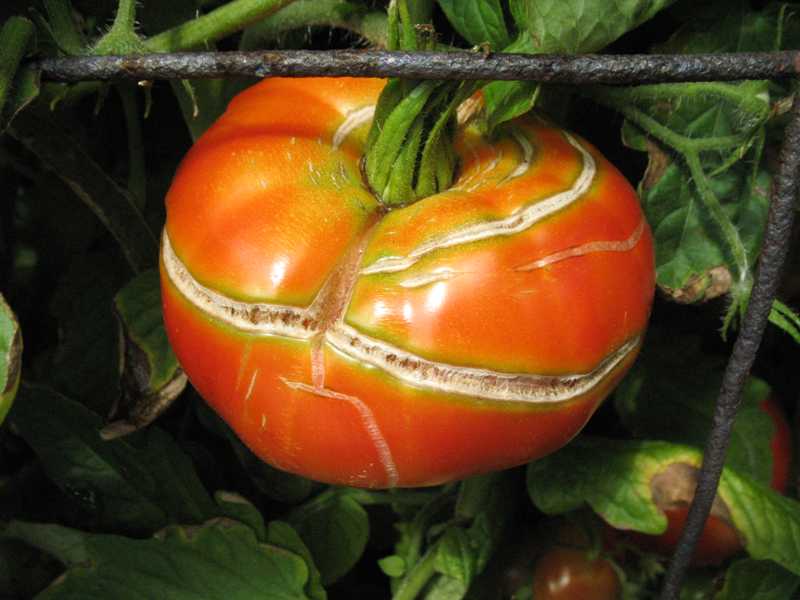Southwest Yard & Garden – Tomato Warning: Side Splits and Shoulder Cracks


Stretch marks on tomatoes are hard to prevent, so go ahead and harvest as soon as you notice them. Photo credit J. Kern.
Question: What’s wrong with these tomatoes? We’re seeing marks developing on some fruit in rings. The insides of the larger splits have white fuzz in them, but when the splits are first observed they do not have this fuzz.
- Kern, Artesia, NM, submitted via Extension Agronomist Dr. Robert Flynn
Answer: Tomatoes across the state (and beyond) are exhibiting two main types of splitting: radial side splitting and concentric cracking. Both tend to be up higher on the fruit shoulder. Radial side splitting looks like someone took a knife and started cutting out a vertical wedge, but then got distracted and stopped a quarter inch or so in. Concentric cracking results in circular or semi-circular lines that start out looking like stretch marks that can break open as they broaden. The good news for you is that tomatoes with radial splits get moldy quicker than those with concentric cracks.

It didn’t take me long to find tomatoes with either radial side splits, concentric cracking, or both. I’m glad I got to these before the mold took over. Photo credits M. Thompson.
Phil Lujan (Diagnostician for NMSU’s Plant Diagnostic Clinic) is all too familiar with local tomato diseases. Lujan told me that, so far this summer, the most prevalent tomato diseases he’s seen include tomato spotted wilt virus, curly top virus, and Fusarium wilt (fungus). Overwatering has also caused Pythium root rot—a fungus that was killing plants earlier in the season. Most tomato problems they’ve analyzed this year were attributed to abiotic (non-living) stressors, like sunscald and heat and drought stress. And really that’s the case each year, for all types of plant samples submitted to the Plant Diagnostic Clinic (https://aces.nmsu.edu/ces/plantclinic/).
In response to this photo of cracking tomatoes in Artesia, Lujan explained, “Skin and fruit cracking is usually due to hot, dry conditions followed by a lot of water, whether it be from heavy irrigation or rain.” Once the inside part is exposed, then secondary fungi or “fuzz” appears.
The cracking isn’t due to under-watering as much as uneven watering. As the fruit develop, they get to a certain point when the skin thickens slightly and the tomato’s size is set. Afterwards, heavy irrigation or a nice rain event can cause skin splitting because the fruit expands beyond the fixed size. Interestingly, the same thing happens in pomegranates. I wrote about that two years ago, and you can find it at https://nmsudesertblooms.blogspot.com/.

Pomegranates split wide open before they were ripe on this backyard tree in Socorro. Photo credit V. Gonzales.
Unlike pomegranates that never ripen more after they’ve been picked, tomatoes continue to ripen off the vine, as long as they’re already mature. This is true for bananas, apples, pears, and for avocados as well. In horticultural terms, the difference between a fruit that’s “ripe” versus “mature” is that mature fruits have fully developed, viable seeds, whereas ripeness refers more to personal preference and marketability—color, texture, and flavor. So this means you can, and should, go ahead and harvest tomatoes that are showing early cracking signs so they can finish ripening (and reddening) inside before the mold takes over.
For a nice mix of tomato support from problem-solving to sauce-making, check out the Bernalillo County Extension Service tomato resource page at https://aces.nmsu.edu/county/bernalillo/yardgarden/tomatoes.html. In the blog version of this column I’ll add links to resources for identifying tomato pests and beneficial insects, as well as links to Dr. Robert Flynn’s excellent soil science videos.
Send gardening questions to Southwest Yard and Garden – Attn: Dr. Marisa Thompson at desertblooms@nmsu.edu, or at the NM Desert Blooms Facebook page (@NMDesertBlooms).
Please copy your County Extension Agent (http://aces.nmsu.edu/county/) and indicate your county of residence when you submit your question!
For more gardening information, visit the NMSU Extension Horticulture page at Desert Blooms (http://desertblooms.nmsu.edu/) and the NMSU Horticulture Publications page at http://aces.nmsu.edu/pubs/_h/.
Marisa Y. Thompson, PhD, is the Extension Horticulture Specialist, in the Department of Extension Plant Sciences at the New Mexico State University Los Lunas Agricultural Science Center.
